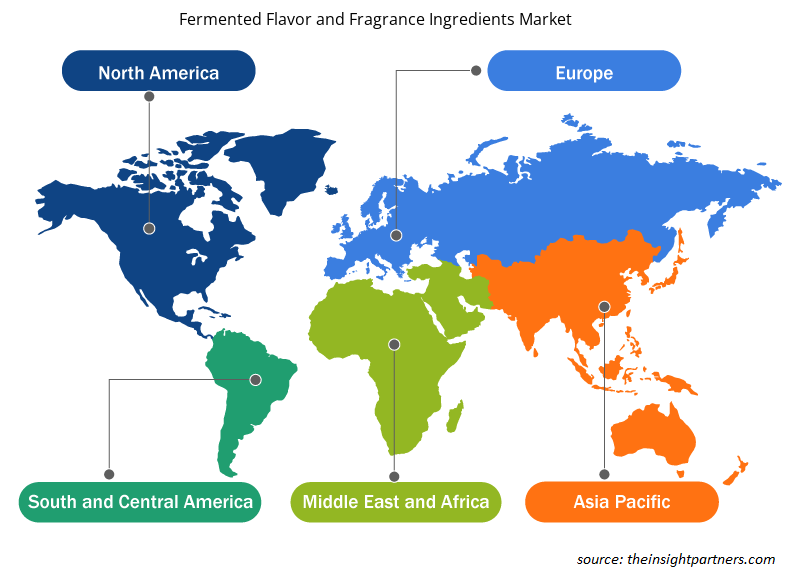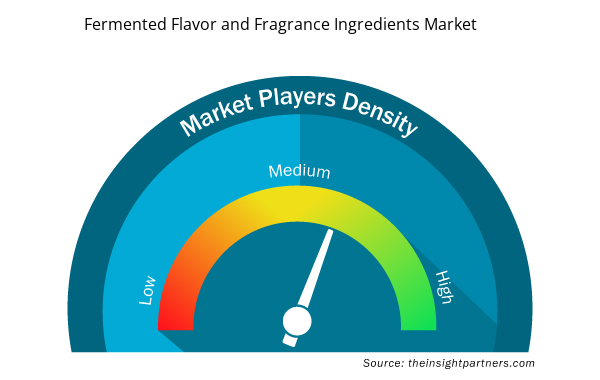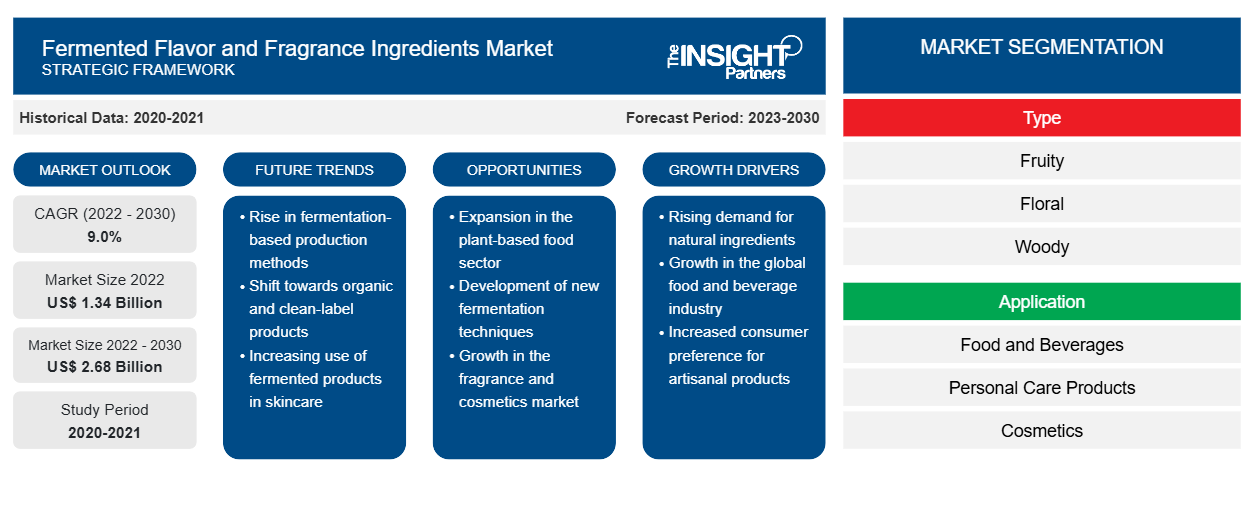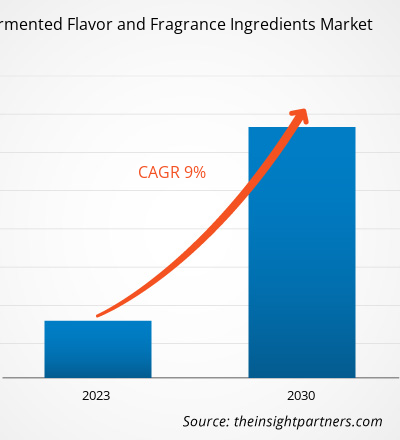[研究报告] 发酵香精香料原料市场规模预计将从 2022 年的 13.4 亿美元增长到 2030 年的 26.8 亿美元;预计 2022 年至 2030 年的复合年增长率为 9.0%。
市场洞察和分析师观点:
香精和香料的发酵成分包括通过微生物发酵工艺生产的调味剂、香料和芳香剂。制造商正在大量投资研发,以生产发酵衍生的香精和香料成分,以满足与天然香精和香料相关的日益增长的可持续性、供应和价格问题。例如,从天然香草豆荚中提取的香兰素非常昂贵,其供应商高度集中在特定地区,这带来了供应挑战。此外,天然香兰素的产量高度依赖于天气条件、农业实践和其他外部因素。这也是一个耗时的过程,通常需要 6-7 个月才能生产完成。当使用微生物发酵工艺生产相同的调味剂时,所有这些挑战都得到了克服。它还可以在更短的时间内获得更高的产量。方便食品以及个人护理和化妆品对天然和清洁标签声明的需求不断增长,以及制造各种调味和香气成分的可持续方法,预计将在未来几年创造新的发酵香精和香料成分市场趋势。
增长动力和挑战:
通过合成提取工艺制成的香精和香料由化学品和其他化石燃料组成,可能危害环境和人类健康。使用化石燃料制成的香精和香料 会增加碳(CO2)和温室气体排放。例如,合成香草香精(称为香兰素)由于价格低廉且容易获得,使用量明显高于天然香草香精。但香兰素是由化石燃料和木浆合成制成的。此外,从香草豆荚中提取的天然香草香精的产量极低。需要 500 公斤香草豆荚才能获得 1 公斤香精。因此,传统使用的香精和香料的天然工艺和合成工艺都是不可持续的。同样,通过种植生产覆盆子香气需要 100 多公吨的覆盆子,相当于约 40 个足球场的耕地面积——这是一种极不可持续的土地利用方式。因此,合成成分的生产以及传统生产的天然成分都会危害环境。
发酵是一种通过可持续方法生产香精和香料的替代技术,也被认为是“天然的”。根据美国环境保护署 (EPA) 的污染防治生物工程研究,发酵是一种比传统化学合成更可持续的生产方法,因为它更节省资源,产生的副产品更少。因此,发酵产生的香精和香料不会损害环境,被标记为天然和可持续的成分。因此,食品和饮料、香水、化妆品和个人护理等终端行业对可持续性的关注日益增加,推动了全球对发酵香精和香料的需求,从而有利于市场增长。这些因素在确定发酵香精和香料成分市场预测方面发挥着重要作用。
全球发酵香精香料制造商正在大力投资战略发展计划,例如产品创新、并购、合作伙伴关系、扩大生产能力和扩大业务,以吸引消费者并提升其市场地位。消费者对可持续性的日益关注以及对天然和清洁标签产品的需求不断增长,促使终端使用行业采用天然和可持续成分。因此,制造商不断在发酵香精香料领域进行投资和创新。例如,2023 年 4 月,以生物为动力的公司 Insempra 推出了其首款功能性成分,一种生物技术生产的 100% 天然“α-紫罗兰酮”香精香料成分,用于食品和化妆品应用。这种风味是通过发酵产生的。该公司还与领先的天然香料成分制造商和分销商“Axxence Aromatic GmbH”合作,向全球食品和化妆品制造商销售其产品。主要市场参与者的此类举措对发酵香精香料成分市场的增长做出了积极贡献。
定制此报告以满足您的需求
您可以免费定制任何报告,包括本报告的部分内容、国家级分析、Excel 数据包,以及为初创企业和大学提供优惠和折扣
- 获取此报告的关键市场趋势。这个免费样品将包括数据分析,从市场趋势到估计和预测。
报告细分和范围:
发酵香精香料成分市场分析考虑了以下几个部分:类型、应用和地理区域。市场按类型分为水果香精、花香精、木香精、混合香精和其他香精。根据应用,市场分为食品和饮料、个人护理产品、化妆品和其他香精。发酵香精香料成分市场按地理区域分为北美(美国、加拿大和墨西哥)、欧洲(德国、法国、意大利、英国、俄罗斯和欧洲其他地区)、亚太地区(澳大利亚、中国、日本、印度、韩国和亚太地区其他地区)、中东和非洲(南非、沙特阿拉伯、阿联酋和中东和非洲其他地区)以及南美洲和中美洲(巴西、阿根廷和南美洲和中美洲其他地区)。
节段分析:
根据类型,发酵香精和香料成分市场细分为水果香精、花香精、木香精、混合香精和其他香精。水果香精在全球发酵香精和香料成分市场占有重要份额。然而,花卉香精市场的市场预计将在预测期内大幅增长。花香香料用于个人护理产品、饮料、香水、织物洗涤剂和家庭护理产品。发酵玫瑰香精通常使用红酵母 (Rhodotorula minuta) 制成。Takasago International Corporation 是香精和香料制造领域的领先公司之一,生产发酵花香香料。他们的产品 Biocyclamol 是通过甘蔗发酵获得的,散发出仙客来花的香味。该产品适用于各种产品,如高级香水、织物柔顺剂、止汗剂、洗护用品、洗涤剂和肥皂。花卉香精市场的市场增长归因于终端使用行业将重点转向发酵花香香料,因为对天然衍生产品的需求不断增加。
区域分析:
根据地理位置,发酵香精香料成分市场报告的范围主要分为五个地区——北美、欧洲、亚太地区、南美和中美以及中东和非洲。2022 年,欧洲占据了全球发酵香精香料成分市场份额的主导地位。2022 年该地区的市场价值为 4.7782 亿美元。然而,预计亚太地区市场在预测期内的复合年增长率将达到 10%。在亚太地区,消费者对天然成分的偏好显著增长。许多消费者认为天然成分比合成成分更健康、更安全、对环境更好。对不含人工或化学加工成分的产品的需求正在增长,包括合成香料、香料、色素和甜味剂。食品和饮料、化妆品、个人护理、家庭护理和个人护理产品行业消费者对天然成分的偏好日益增长,推动了对发酵香精香料的需求。日本、中国、韩国、澳大利亚和印度等国家的城市化进程不断加快,中产阶级人口不断增加,对天然产品的需求也不断增加。人们对可持续性的关注度不断上升,也推动了对微生物香精和香料的需求。
亚太地区的美容行业发展迅速。从事美容行业的公司也采用可持续的采购和制造实践来提高产品性能并减少对环境的影响。因此,所有这些因素都有望推动该地区发酵香精和香料成分市场的发展。
在欧洲,人们对某些香精香料成分(如香草、檀香和沉香)的可持续性和环境影响的担忧日益增加,推动了对发酵香精香料成分的需求。因此,该地区的制造商已投入大量资金生产可持续成分。例如,总部位于欧洲的跨国公司 Koninklijke DSM NV 和 BASF 与一家名为 Allylix 的公司合作,共投资 1350 万美元用于微生物生产香精香料分子。制造商的此类投资有助于促进欧洲发酵香精香料成分市场的增长。
发酵香精和香料成分市场区域洞察
Insight Partners 的分析师已详尽解释了预测期内影响发酵香精和香料成分市场的区域趋势和因素。本节还讨论了北美、欧洲、亚太地区、中东和非洲以及南美和中美洲的发酵香精和香料成分市场细分和地理位置。

- 获取发酵香精香料成分市场的区域特定数据
发酵香精和香料成分市场报告范围
| 报告属性 | 细节 |
|---|---|
| 2022 年市场规模 | 13.4亿美元 |
| 2030 年的市场规模 | 26.8亿美元 |
| 全球复合年增长率(2022 - 2030 年) | 9.0% |
| 史料 | 2020-2021 |
| 预测期 | 2023-2030 |
| 涵盖的领域 | 按类型
|
| 覆盖地区和国家 | 北美
|
| 市场领导者和主要公司简介 |
|
发酵香精和香料成分市场参与者密度:了解其对业务动态的影响
发酵香精香料市场正在快速增长,这得益于终端用户需求的不断增长,这些需求源于消费者偏好的不断变化、技术进步以及对产品优势的认识不断提高等因素。随着需求的增加,企业正在扩大其产品范围,进行创新以满足消费者的需求,并利用新兴趋势,从而进一步推动市场增长。
市场参与者密度是指在特定市场或行业内运营的企业或公司的分布情况。它表明在给定市场空间中,相对于其规模或总市场价值,有多少竞争对手(市场参与者)存在。
在发酵香精和香料成分市场运营的主要公司有:
- 珍妮尔生物科技公司
- 德国多勒有限公司
- 高砂国际股份有限公司
- 奇华顿公司
- 巴斯夫
免责声明:上面列出的公司没有按照任何特定顺序排列。

- 获取发酵香精和香料成分市场顶级关键参与者概览
行业发展和未来机遇:
全球发酵香精和香料成分市场的主要参与者采取的举措如下:
- 2020 年 7 月,德国跨国公司巴斯夫营养与健康部和荷兰公司 Isobionics 推出了首款发酵香精“Isobionics 檀香醇”,为最终产品带来木质香味。这种香味是檀香油的有力替代品。
- 2023 年 2 月,Givaudan SA 从 Amyris Inc. 收购了某些化妆品成分,包括 Neossance Squalane、Neossance Hemisqualane 和 CleanScreen。长期合作协议将允许 Amyris 继续生产供 Givaudan 用于化妆品的成分,并提供其创新能力。
竞争格局和重点公司:
Givaudan SA、Firmenich International SA、Takasago International Corp、BASF SE、Evolva Holding SA、Amyris Inc、Insempra GmbH、Conagen Inc、Jeneil Biotech Inc 和 Dohler GmbH 是全球发酵香精香料成分市场报告中介绍的知名企业。这些市场参与者采取战略发展举措,在全球范围内拓展业务。
- 历史分析(2 年)、基准年、预测(7 年)及复合年增长率
- PEST 和 SWOT 分析
- 市场规模价值/数量 - 全球、区域、国家
- 行业和竞争格局
- Excel 数据集


- Dried Blueberry Market
- Batter and Breader Premixes Market
- Rugged Phones Market
- Small Molecule Drug Discovery Market
- Nitrogenous Fertilizer Market
- Cell Line Development Market
- Wire Harness Market
- Battery Testing Equipment Market
- Queue Management System Market
- Trade Promotion Management Software Market

Report Coverage
Revenue forecast, Company Analysis, Industry landscape, Growth factors, and Trends

Segment Covered
This text is related
to segments covered.

Regional Scope
North America, Europe, Asia Pacific, Middle East & Africa, South & Central America

Country Scope
This text is related
to country scope.
常见问题
The fruity segment held a dominating share of the fermented flavor and fragrance ingredients market in 2022 owing to rising demand for fruity flavors and fragrances such as citrus, berry, and exotic fruits including mango and pineapple due to their refreshing sweet aroma and taste.
Based on application, the cosmetics segment is expected to register the fastest growth rate due to rising demand for natural, non-toxic, and chemical-free cosmetics.
Europe held the largest fermented flavor and fragrance ingredients market share due to rising awareness regarding sustainability and increasing preference for natural and non-toxic ingredients.
The major players operating in the global fermented flavor and fragrance ingredients market are Jeneil Biotech Inc, Dohler GmbH, Takasago International Corp, Givaudan SA, BASF SE, Firmenich International SA, Amyris Inc, Insempra GmbH, Conagen Inc, and Evolva Holding SA.
Rising technological advancements that help the scaling-up of production of flavor and fragrances through fermentation is expected to provide lucrative opportunities in the market over the coming years.
Rising sustainability concerns and key initiatives adopted by the key manufacturers of fermented flavor and fragrance ingredients are the major growth driving factors.
Trends and growth analysis reports related to Food and Beverages : READ MORE..
The List of Companies - Fermented Flavor and Fragrance Ingredients Market
- Jeneil Biotech Inc
- Dohler GmbH
- Takasago International Corp
- Givaudan SA
- BASF SE
- Firmenich International SA
- Amyris Inc
- Insempra GmbH
- Conagen Inc
- Evolva Holding SA
The Insight Partners performs research in 4 major stages: Data Collection & Secondary Research, Primary Research, Data Analysis and Data Triangulation & Final Review.
- Data Collection and Secondary Research:
As a market research and consulting firm operating from a decade, we have published and advised several client across the globe. First step for any study will start with an assessment of currently available data and insights from existing reports. Further, historical and current market information is collected from Investor Presentations, Annual Reports, SEC Filings, etc., and other information related to company’s performance and market positioning are gathered from Paid Databases (Factiva, Hoovers, and Reuters) and various other publications available in public domain.
Several associations trade associates, technical forums, institutes, societies and organization are accessed to gain technical as well as market related insights through their publications such as research papers, blogs and press releases related to the studies are referred to get cues about the market. Further, white papers, journals, magazines, and other news articles published in last 3 years are scrutinized and analyzed to understand the current market trends.
- Primary Research:
The primarily interview analysis comprise of data obtained from industry participants interview and answers to survey questions gathered by in-house primary team.
For primary research, interviews are conducted with industry experts/CEOs/Marketing Managers/VPs/Subject Matter Experts from both demand and supply side to get a 360-degree view of the market. The primary team conducts several interviews based on the complexity of the markets to understand the various market trends and dynamics which makes research more credible and precise.
A typical research interview fulfils the following functions:
- Provides first-hand information on the market size, market trends, growth trends, competitive landscape, and outlook
- Validates and strengthens in-house secondary research findings
- Develops the analysis team’s expertise and market understanding
Primary research involves email interactions and telephone interviews for each market, category, segment, and sub-segment across geographies. The participants who typically take part in such a process include, but are not limited to:
- Industry participants: VPs, business development managers, market intelligence managers and national sales managers
- Outside experts: Valuation experts, research analysts and key opinion leaders specializing in the electronics and semiconductor industry.
Below is the breakup of our primary respondents by company, designation, and region:

Once we receive the confirmation from primary research sources or primary respondents, we finalize the base year market estimation and forecast the data as per the macroeconomic and microeconomic factors assessed during data collection.
- Data Analysis:
Once data is validated through both secondary as well as primary respondents, we finalize the market estimations by hypothesis formulation and factor analysis at regional and country level.
- Macro-Economic Factor Analysis:
We analyse macroeconomic indicators such the gross domestic product (GDP), increase in the demand for goods and services across industries, technological advancement, regional economic growth, governmental policies, the influence of COVID-19, PEST analysis, and other aspects. This analysis aids in setting benchmarks for various nations/regions and approximating market splits. Additionally, the general trend of the aforementioned components aid in determining the market's development possibilities.
- Country Level Data:
Various factors that are especially aligned to the country are taken into account to determine the market size for a certain area and country, including the presence of vendors, such as headquarters and offices, the country's GDP, demand patterns, and industry growth. To comprehend the market dynamics for the nation, a number of growth variables, inhibitors, application areas, and current market trends are researched. The aforementioned elements aid in determining the country's overall market's growth potential.
- Company Profile:
The “Table of Contents” is formulated by listing and analyzing more than 25 - 30 companies operating in the market ecosystem across geographies. However, we profile only 10 companies as a standard practice in our syndicate reports. These 10 companies comprise leading, emerging, and regional players. Nonetheless, our analysis is not restricted to the 10 listed companies, we also analyze other companies present in the market to develop a holistic view and understand the prevailing trends. The “Company Profiles” section in the report covers key facts, business description, products & services, financial information, SWOT analysis, and key developments. The financial information presented is extracted from the annual reports and official documents of the publicly listed companies. Upon collecting the information for the sections of respective companies, we verify them via various primary sources and then compile the data in respective company profiles. The company level information helps us in deriving the base number as well as in forecasting the market size.
- Developing Base Number:
Aggregation of sales statistics (2020-2022) and macro-economic factor, and other secondary and primary research insights are utilized to arrive at base number and related market shares for 2022. The data gaps are identified in this step and relevant market data is analyzed, collected from paid primary interviews or databases. On finalizing the base year market size, forecasts are developed on the basis of macro-economic, industry and market growth factors and company level analysis.
- Data Triangulation and Final Review:
The market findings and base year market size calculations are validated from supply as well as demand side. Demand side validations are based on macro-economic factor analysis and benchmarks for respective regions and countries. In case of supply side validations, revenues of major companies are estimated (in case not available) based on industry benchmark, approximate number of employees, product portfolio, and primary interviews revenues are gathered. Further revenue from target product/service segment is assessed to avoid overshooting of market statistics. In case of heavy deviations between supply and demand side values, all thes steps are repeated to achieve synchronization.
We follow an iterative model, wherein we share our research findings with Subject Matter Experts (SME’s) and Key Opinion Leaders (KOLs) until consensus view of the market is not formulated – this model negates any drastic deviation in the opinions of experts. Only validated and universally acceptable research findings are quoted in our reports.
We have important check points that we use to validate our research findings – which we call – data triangulation, where we validate the information, we generate from secondary sources with primary interviews and then we re-validate with our internal data bases and Subject matter experts. This comprehensive model enables us to deliver high quality, reliable data in shortest possible time.


 获取此报告的免费样本
获取此报告的免费样本